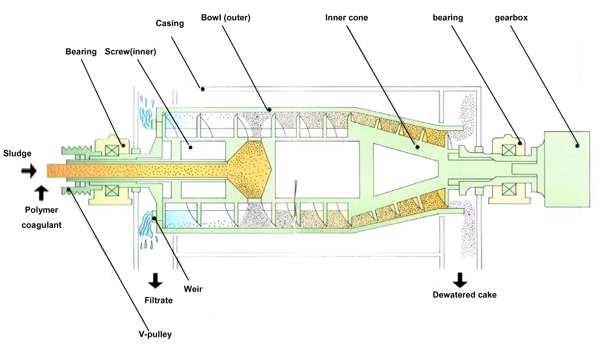Dewatering Methods
There are many different dewatering methods. These include centrifuges, filter presses, drying beds, sludge lagoons, and gravity and low pressure devices. Each method is described in detail below.
Centrifuges
Centrifuges separate solids from liquids through sedimentation and centrifugal force. Solids are fed through a stationary feed tube, accelerated through ports in the conveyor shaft, and distributed to the periphery of the bowl. The bowl, spinning at high speeds, separates the water from the solids which are compacted against the bowl walls. Solids can then be conveyed to additional centrifuge drying stages while the separated liquid is discharged continuously over adjustable weirs at the other side of the bowl.

Figure 1 – Diagram of a typical dewatering centrifuge. Image Credit: Global Environment Centre
| Parameter and Performance Correlations for Centrifuges | |||||||
| Performance & Parameters | Pool Volume | Bowl Speed | Conveyor Speed | Feed Rate | Feed Consistency | Temperature | Flocculent Usage |
| Cake Dryness | Inverse | Direct | Inverse | Direct | Inverse | Direct | Inverse |
| Solids Recovery | Direct | Direct | Inverse | Inverse | Direct | Direct | Direct |
- last page:How It Works Sludge dewatering 2013/7/23
- next pageWhat is Dewatering Equipment 2013/7/23
